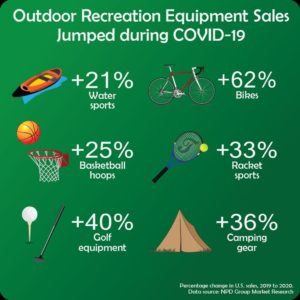Opinion-Editorial June 9, 2021
by Tim Herd and Marci Mowery
As go our parks and public spaces, so goes our health and wellbeing.
Last year confirmed what many know—that parks and recreation is unquestionably essential. Through every phase of the pandemic, our community and state parks and forests provided much needed space for enhancing physical, mental and emotional health, while also providing places to connect with family and friends.
Meanwhile, park, forest and recreation providers worked tirelessly to keep individuals safe, delivering vital emergency services, distributing meals, offering recreational opportunities that promote physical and mental health, and keeping our parks safe, clean and ready to use.
And all this during the period when the same professionals were dealing with cutbacks, furloughs, lockdowns and working from home, while record numbers of people flocked to the parks and trails for mental and physical relief. In some counties in Pennsylvania, mobility to the local parks surged over 280 percent in the month of May alone! Our state parks saw more visitors than ever – nearly 47 million—an increase of greater than 26 percent over 2019.
It simply and strongly demonstrates that parks are indispensable to our personal, social and community health. And our economy.
 The accompanying chart shows the increase of recreation equipment sales. Some businesses near parks and forests had record sales due to increased visitation.
The accompanying chart shows the increase of recreation equipment sales. Some businesses near parks and forests had record sales due to increased visitation.
Yet parks are also underappreciated when it comes to reinvesting in them for our own good. Research has shown that during times of financial stress, parks are the first of public services to be cut, and are among the last to recover. Meanwhile, decreased staff, increased usage, and a growing backlog of maintenance—state parks and forests need $1 billion for crucial access and safety needs—are taking their toll on these essential public spaces and services that support a thriving populace.
Fortunately, The American Rescue Plan provides direct aid to state and local governments for infrastructure investments; for offsetting revenue losses from COVID and responding to the public health emergency; and for critical capital projects directly enabling work, education, and health monitoring, among others.
Such a constructive investment is not only socially and environmentally sound; it also makes direct economic sense. The outdoor recreation economy in Pennsylvania generates $29.1 billion in economic activity, produces 251,000 direct jobs, and contributes $8.6 billion in wages and salaries, and $1.9 billion in state and local tax revenue. (Outdoor Industry Association, 2017.)
However, as appropriate and timely as the Plan’s provisions are, they do not automatically flow to the owners and stewards of our public parks, trails and greenspaces. We strongly support any funding designated for recovery and reimbursement of COVID-related expenses to extend to the costs of repairing, renewing and operating our precious public assets, and to build better resilience against future distresses. We encourage our General Assembly to acknowledge the vital role these spaces play in our communities by investing ARP funding to benefit all Pennsylvanians.
An open, robust, and well-maintained system of parks, forests and public spaces strengthens us all.
###
Tim Herd, CPRE, is the CEO of the Pennsylvania Recreation and Park Society, the principal statewide association providing professional development, leadership, advocacy and resources for those working and volunteering in the parks and recreation field.
Marci Mowery is the President of the Pennsylvania Parks and Forests Foundation, a charity dedicated to the stewardship of the Commonwealth’s state parks and forests through public engagement in volunteerism, education and recreation.




